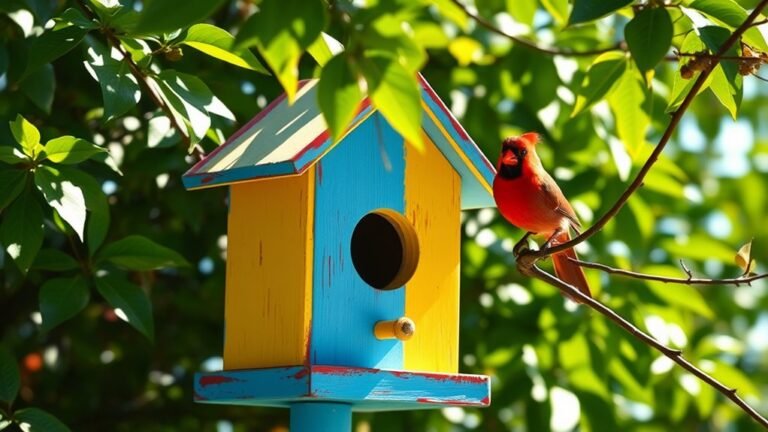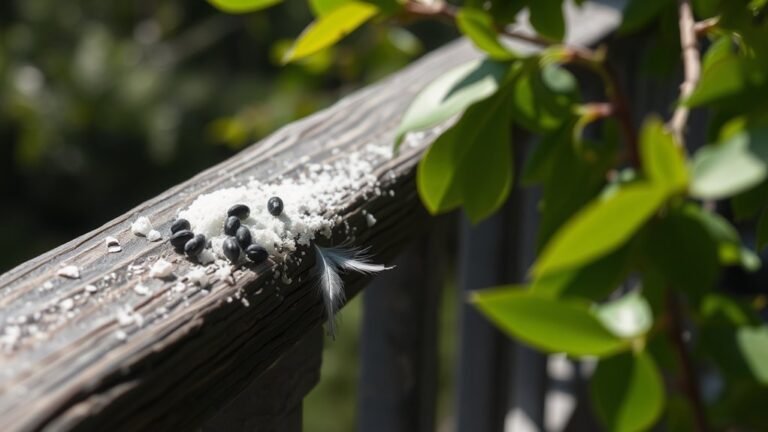What Birds Love Mealworms? Feeding Tips for Insectivores
If you want to attract birds to your yard, mealworms can help. Birds like blue jays and chickadees enjoy these tasty treats. Mealworms provide important nutrients for them. To attract more birds, follow simple feeding tips.
First, use a clean dish to serve the mealworms. Place the dish in a visible spot. This way, birds can see the food easily. Offer fresh mealworms daily. Keep an eye on how much food is left, so you can refill it when needed.
If you notice birds coming to your yard, keep feeding them. They'll start to recognize your place as a reliable food source. Remember, different birds have different preferences. It can be fun to observe what birds visit your yard.
Overall, providing mealworms can enhance your birdwatching experience. Just keep it simple and enjoy the sights and sounds of your feathered friends.
Key Takeaways
Blue jays and chickadees enjoy mealworms as a tasty and nutritious treat. These insects provide protein, fats, vitamins, and calcium, which help support bird health and energy.
To feed birds, place mealworms in a shallow dish or platform feeder. This setup allows birds easy access to food every day. Many birds have a preference for fresh mealworms, but dried mealworms are also a good option since they are convenient and last longer.
Be careful not to overfeed birds. This helps them maintain their natural foraging behavior. Also, store mealworms properly to avoid spoilage. Providing mealworms can attract and support a variety of bird species, making your feeding efforts enjoyable.
Popular Bird Species That Enjoy Mealworms
Many bird species enjoy mealworms as a tasty treat.
Two birds you might see are blue jays and chickadees. Blue jays come in bright colors and are smart foragers. They look for mealworms with skill and can open seeds and find insects easily.
Chickadees are small and playful. They often visit feeders with mealworms and move quickly from branch to branch, happily picking up your food.
The Nutritional Benefits of Mealworms for Birds
Mealworms provide a rich source of nutrition for many bird species. They contain high levels of protein, essential fats, and vital vitamins that are crucial for bird health.
These nutrients support muscle growth and boost energy, which helps birds during breeding and migration. Mealworms also have calcium, which is important for bone health and egg production.
Adding mealworms to your feeding routine attracts a variety of birds and ensures they receive the nutrients they need. By offering mealworms, you support local wildlife and create a meaningful connection with nature.
How to Offer Mealworms: Best Practices
To attract birds with mealworms, follow these best practices for success.
First, store mealworms in a cool, dark place or in the refrigerator to keep them fresh. This makes them more appealing to birds.
Next, feed mealworms daily to provide a steady food source. This encourages birds to return frequently.
Use a shallow dish or platform feeder for easy access. Clean feeders regularly to prevent mold and bacteria. This creates a healthy feeding space.
Attracting Insectivorous Birds to Your Yard
Attracting insectivorous birds to your yard can improve your birdwatching. To invite these birds, use specialized feeders for mealworms and suet. These feeders provide a steady food supply.
Additionally, plant native plants and shrubs to create a friendly environment. Insects thrive in diverse settings, so include flowers and grasses that attract them.
Keep your yard clean and provide fresh water sources. These steps will attract insectivorous birds to your space.
With these techniques, you'll create an engaging bird-friendly area that adds joy to your outdoor enjoyment.
Feeding Mealworms: Fresh vs. Dried Options
When choosing between fresh and dried mealworms, consider the needs of the birds you want to attract. Fresh mealworms have a natural texture and moisture that many birds prefer. On the other hand, dried mealworms are convenient and last longer.
Here are three key factors to keep in mind:
- Bird Preferences: Some birds enjoy the taste and texture of fresh mealworms more than dried ones.
- Availability: Fresh mealworms may be harder to find, while dried mealworms are typically easy to purchase.
- Feeding Frequency: Dried mealworms stay fresh longer when left out, making them suitable for quick feeding.
Understanding these factors will help you create an appealing feeding environment for your birds, allowing them to enjoy either fresh or dried mealworms based on their preferences.
Common Feeding Mistakes to Avoid
Feeding birds is enjoyable, but common mistakes can drive them away. One mistake to avoid is overfeeding. Providing too much food can reduce birds' natural foraging and lead to health problems. It's important to give the right amount of mealworms based on the needs of the birds visiting your feeder.
Another mistake is improper mealworm storage. Storing them incorrectly can cause spoilage, which is harmful to birds.
Keep dried mealworms in a cool, dry place, and always check for mold or pests. By avoiding these mistakes, you can create a safe and welcoming space for birds in your yard.
Enhancing Your Backyard Habitat for Birds
Enhancing your backyard habitat for birds is easy when you know what they need. Here are three important steps to create a welcoming space:
- Choose Native Plants: Select plants that grow naturally in your area. Native plants offer food and shelter for local birds all year long.
- Add Structures: Put up birdhouses, feeders, and water sources. These items give birds a safe place to rest and find food.
- Create Layers: Use a variety of trees, shrubs, and ground plants. This mix attracts different bird species and builds a lively ecosystem.
Following these steps will help you attract more birds to your yard, making it vibrant and full of life.
Enjoy observing the birds and their behavior in your enhanced habitat!
Frequently Asked Questions
Can Mealworms Be Harmful to Certain Bird Species?
Mealworms are not toxic to birds, but overfeeding them can harm a bird's digestive system. Some bird species may have difficulty processing high protein levels from mealworms, which can lead to health problems. It is important to feed mealworms in moderation and understand the specific dietary needs of each bird for better health.
How Often Should I Feed Mealworms to Backyard Birds?
To decide how often to feed mealworms to backyard birds, watch their eating habits. It is best to provide mealworms a few times each week. This approach ensures that birds receive a varied diet without becoming too reliant on mealworms. Feeding them regularly helps create an enjoyable and diverse feeding experience for your feathered friends.
Are There Any Alternatives to Mealworms for Insectivorous Birds?
If you want alternatives to mealworms, consider baking insects like crickets or other substitutes. These insects provide excellent protein sources for insectivorous birds. Using various options can make your feeding routine more interesting and enjoyable for both you and the birds. Explore different types of insects to meet their dietary needs while keeping things diverse.
What Time of Year Is Best for Feeding Mealworms?
When deciding when to feed mealworms, consider the seasons. Spring and summer are the best times. During these months, the weather is warmer, which increases the activity of insect-eating birds. This encourages more birds to visit your feeders. Feeding mealworms during this time can attract a variety of birds and enhance your birdwatching experience.
Can I Raise My Own Mealworms at Home?
Yes, you can raise mealworms at home. First, create a habitat using soil and grains. Then, keep the right temperature and humidity levels. This will help ensure a steady supply of mealworms for feeding. Enjoy the process and watch your mealworms grow!

Ava is a bird enthusiast and nature lover who has spent countless hours observing and learning about the fascinating world of birds. With a passion for sharing her knowledge and inspiring others to appreciate the beauty of birds, Ava writes about her experiences and insights on avianadmirer.com.







